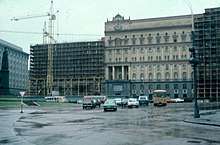Lubyanka Square
Lubyanskaya Square (Russian: Лубянская площадь, Lubyanskaya ploshchad'), or simply Lubyanka in Moscow lies about 900 metres (980 yd) north-east of Red Square. History first records its name in 1480, when Grand Prince Ivan III of Moscow, who had conquered Novgorod in 1471, settled many Novgorodians in the area. They built the church of St Sophia, modelled after St Sophia Cathedral in Novgorod, and called the area Lubyanka after the Lubyanitsy district of their native city.
 FSB headquarters in Lubyanka Square | |
| Native name | Лубянская площадь |
|---|---|
| Location | Moscow Central Administrative Okrug Tverskoy District |
| Postal code | 101000 |
| Nearest metro station | |
| Coordinates | 55°45′34″N 37°37′37″E |
Name
The square was renamed Dzerzhinsky Square for many years (1926–1990) in honor of the founder of the Soviet security service Felix Dzerhinsky.
Square center
A fountain used to stand in front of the building, at the center of the Lubyanka Square. In 1958, the fountain at the center of the Lubyanka Square was replaced by an 11-ton statue of Felix Dzerzhinsky ("Iron Felix") made by Yevgeny Vuchetich, founder of the Cheka.[1]
On October 30, 1990, the Memorial organization erected the Solovetsky Stone, a monument to the victims of the Gulag, a simple stone from the Solovki prison camp in the White Sea. In 1991 the statue of Dzerzhinsky was removed by liberal protesters following the failure of the coup attempt against Mikhail Gorbachev, and the square's original name was officially restored.
Lubyanka Building
Lubyanka Square is best known for the monumental Lubyanka Building, designed by Aleksandr V. Ivanov and constructed from 1897 to 1898. Originally built for the insurance company Rossiya, it later became better known for housing the headquarters of the KGB in its various incarnations. As of 2016 the Federal Security Service of the Russian Federation (FSB) occupies the building.
Detsky Mir
Opposite the FSB building stands the massive Detsky Mir (Russian: Де́тский мир, "Children World"), Europe's largest children's store, built between 1953 and 1957,[2] and fully restored in 2014. It hosts in its main atrium the world's largest mechanical clock movement: Raketa Monumental.[3][4][5]
Metro
The Moscow Metro station Lubyanka operates under Lubyanka Square.
Gallery
 Lubyanka Square in the early 1900s
Lubyanka Square in the early 1900s Dzerzhinsky Square in 1966, with the statue of Felix Dzerzhinsky
Dzerzhinsky Square in 1966, with the statue of Felix Dzerzhinsky KGB building in 1983
KGB building in 1983 The Solovetsky Stone monument
The Solovetsky Stone monument A less common view
A less common view
References
- RIR; Romendik, Dmitriy (2014-02-11). "The dark history of Lubyanka". www.rbth.com. Retrieved 2020-08-09.
- Richardson, Dan (2001). The Rough Guide to Moscow. Rough Guides. ISBN 978-1-85828-700-3.
- "Do not advertise a past dark with pain". The Financial Times. Retrieved 3 September 2015.
- Ilya Khrennikov (31 March 2015). "Hamleys Moscow Store Transcends Toy Retailer's London Flagship". Bloomberg. Retrieved 3 September 2015.
- "Механические часы В ЦДМ на Лубянке производства ПЧЗ "Ракета" - Русские часы: Ракета / Russian Watches: Raketa". Raketa.com. Archived from the original on 5 September 2015. Retrieved 3 September 2015.
External links
| Wikimedia Commons has media related to Lubyanka Square. |